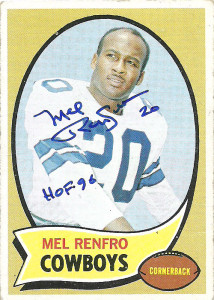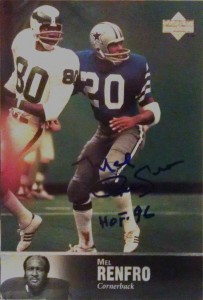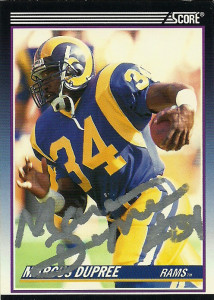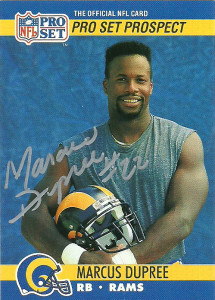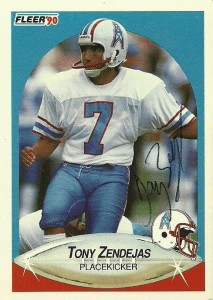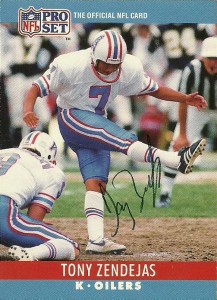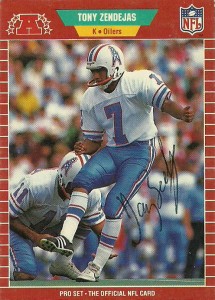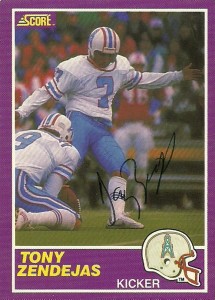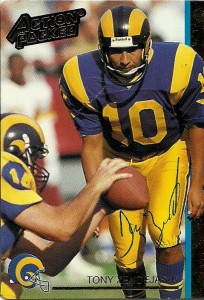Cards: Upper Deck Legends 1997, Topps 1971, Top Notch Signature Select 2013, HoF postcard
Acquired: TTM 2014, C/o Home*
Sent: 2/10 Received: 2/18 (8 days)
* Signing fee of $10 per flat included.
 Mel Renfro was a star 2 way player for Oregon, playing both cornerback and tailback, while also excelling at track for the Ducks. After rushing for 1,532 yards for the Ducks over 3 years, he was drafted in the second round by the Dallas Cowboys in 1964. Intially slotted to play runningback Coach Landry made the call to move him to safety where he had an outstanding rookie season with 7 interceptions, and was the NFL leader in kick and punt return yards. In his second season the Cowboys switched Mel back to runningback in the hopes that he’d inject some life into the offense, but was returned to defense with the emergence of Dan Reeves.
Mel Renfro was a star 2 way player for Oregon, playing both cornerback and tailback, while also excelling at track for the Ducks. After rushing for 1,532 yards for the Ducks over 3 years, he was drafted in the second round by the Dallas Cowboys in 1964. Intially slotted to play runningback Coach Landry made the call to move him to safety where he had an outstanding rookie season with 7 interceptions, and was the NFL leader in kick and punt return yards. In his second season the Cowboys switched Mel back to runningback in the hopes that he’d inject some life into the offense, but was returned to defense with the emergence of Dan Reeves.
Although he held the designation of return specialist for much of the next few years, Renfro moved from safety to corner in 1966, culminating in leading the NFL in 1969 with 10 interceptions. Over his career with the Cowboys Mel was named All Pro 5 times, and to the Pro Bowl 10. A two time Super Bowl champion, Renfro was co-MVP of the 1970 Pro Bowl and named to the Dallas Cowboys’ Ring of Honor in 1981. Mel is the team’s all-time leader in both career kickoff return average and interceptions. Renfro was inducted into the NFL HoF in 1996.
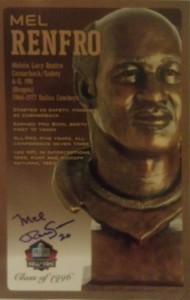
He’s spent some time coaching in the USFL with the Express, and the St. Louis Cardinals. A motivational speaker, Mel is pretty engaging with fans. I missed out at Dallas Stadium Fan Day at the end of the year. My timing was perfect to get Rocket Ismail, but so perfect, Mel came out just as I finished getting Rocket- so I ended up having to go to the very back of the line. I went ahead and wrote him a few days later including the customary signing fee. Renfro signed all the cards I enclosed, and as a bonus included an autographed Hall of Fame postcard, a signed business card, and he asked if I could send him an extra copy of the custom Top Notch card that I sent. A very short wait for such a great return, and a fair price to boot.
The Topps 1971 set has grown on me over the years and is a seminal classic to me. On the other hand the Upper Deck Legends 1997 is very disappointing. Considered a classic as well in its own right, I was pretty disappointed in this entry. The photo is not inspired, and it even looks like a thumb got in on the action on the left side. Sad. The profile photo of Mel is also from later in his career. I went for some action photos for Mel’s Top Notch entry. I very much enjoy the classic press photo shots that were very popular during the 70s and used two different ones for either side.
G/Gs 174/152 Pr 109 Yds 842 Avg 7.7 Td 1 Lg 69t
Kr 85 Yds 2246 Avg 26.4 Td 2 Lg 100t
Tac N/a Sac N/a Fum 12 Int 52 Yds 626 Avg 12.0 Td 3 Lg 90t
